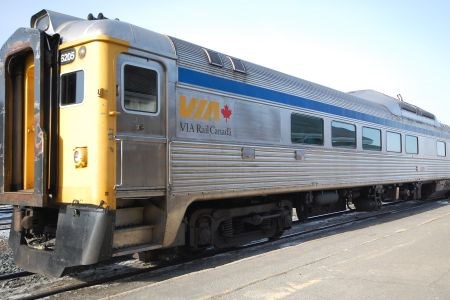Keep an eye on VIA Rail’s line for the newly-refurbished Budd baggage car, expected to arrive sometime in May 2011.
Three of the world’s remaining six selfpropelled rail diesel cars (RDCs) still providing regular service have run in Northern Ontario between Sudbury and White River since about 1990.
The train services up to 31 communities, covering 484 kilometres. The other three trains operate on Vancouver Island.
The RDC cars were built in the 1950s by the world-renowned Budd Company of Philadelphia.
These sturdy stainless steel cars were designed to link together, with detachable controls, allowing the driver to move the train in either direction without having to turn the car around.
Since last March’s announcement that the company’s six running Budd cars would undergo an extensive rebuild and complete modernization, Industrial Rail Services Inc. of Moncton, N.B. has been hard at work rebuilding the RDCs from the inside out.
The $12.6-million project was funded by the federal government.
VIA Rail spokesperson Catherine Kaloutsky said the baggage car will be the first one to be delivered for the Sudbury-White River route, just in time for peak period, starting in June through to September.
“During the peak period, it is a very popular route for campers and hunters,” said Kaloutsky. “While it may not be as heavily populated as some of our other routes, it does provide a service to those communities, some of which are remote or landlocked.”
In some cases, a train is either the most efficient or only way to get between some of the communities.
The cars are being gutted, leaving the outer shell, the seat frames and the wheels.
The refurbishment will involve new compressors, wiring, electrical controls, LED interior lighting, auxiliary power units, ventilation, air conditioning, and heating systems, fully-rebuilt diesel engines that meet stringent emissions standards, and fully-rebuilt air brakes.
Cab-mounted video cameras will be installed for increased safety.
Completely new interiors in a cool, calming colour scheme comprised of slate green, teal, grey and midnight blue tones with beige-coloured drapes and leather seat cushions will give the car a fresh clean look.
One car will also have a fully accessible wheelchair washroom as well as a builtin wheelchair lift.
The baggage car will have bike racks that when not in use, will collapse to make room for other luggage.
The work area has improved for the crew, which has a small kitchenette for their meals. One change is that the engineer will access the cab from the outside instead of from the inside, now a standard practice on other locomotives.
The inside door will become an emergency exit.
The remaining two cars will be ready to undergo a 1,000-mile test run in Ontario by the fall, said Kaloutsky.
This means the trains will be run on VIA-owned tracks during the off hours. She expects they will be in service by January or February 2012.
“We refer to it as being the human way to travel,” Kaloutsky said, explaining that it is a relaxing, beautiful way to travel between the two locations, and as the price of gas escalates, it is a manageable cost, more environmentally-friendly, and runs during inclement weather.
“The train is a great option because of the environmental savings,” she said. “If we can get people out of their cars and into trains, it is a win-win for everybody because we are protecting our environment and lessening our carbon footprint.”




